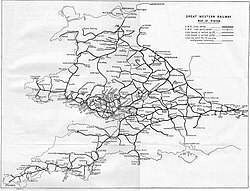Bristol–Exeter line
| Bristol to Exeter line | |||
|---|---|---|---|
standard gauge | |||
| Operating speed | 110 mph (177 km/h) maximum | ||
| |||
Bristol–Exeter line | |||||||||||||||||||||||||||||||||||||||||||||||||||||||||||||||||||||||||||||||||||||||||||||||||||||||||||||||||||||||||||||||||||||||||||||||||||||||||||||||||||||||||||||||||||||||||||||||||||||||||||||||||||||||||||||||||||||||||||||||||||||||||||||||||||||||||||||||||||||||||||||||||||||||||||||||||||||||||||||||||||||||||||||||||||||||||||||||||||||||||||||||||||||||||||||||||||||||||||||||||||||||||||||||||||||||||||||||||||||||||||||||||||||||||||||||||||||||||||||||||||||||
|---|---|---|---|---|---|---|---|---|---|---|---|---|---|---|---|---|---|---|---|---|---|---|---|---|---|---|---|---|---|---|---|---|---|---|---|---|---|---|---|---|---|---|---|---|---|---|---|---|---|---|---|---|---|---|---|---|---|---|---|---|---|---|---|---|---|---|---|---|---|---|---|---|---|---|---|---|---|---|---|---|---|---|---|---|---|---|---|---|---|---|---|---|---|---|---|---|---|---|---|---|---|---|---|---|---|---|---|---|---|---|---|---|---|---|---|---|---|---|---|---|---|---|---|---|---|---|---|---|---|---|---|---|---|---|---|---|---|---|---|---|---|---|---|---|---|---|---|---|---|---|---|---|---|---|---|---|---|---|---|---|---|---|---|---|---|---|---|---|---|---|---|---|---|---|---|---|---|---|---|---|---|---|---|---|---|---|---|---|---|---|---|---|---|---|---|---|---|---|---|---|---|---|---|---|---|---|---|---|---|---|---|---|---|---|---|---|---|---|---|---|---|---|---|---|---|---|---|---|---|---|---|---|---|---|---|---|---|---|---|---|---|---|---|---|---|---|---|---|---|---|---|---|---|---|---|---|---|---|---|---|---|---|---|---|---|---|---|---|---|---|---|---|---|---|---|---|---|---|---|---|---|---|---|---|---|---|---|---|---|---|---|---|---|---|---|---|---|---|---|---|---|---|---|---|---|---|---|---|---|---|---|---|---|---|---|---|---|---|---|---|---|---|---|---|---|---|---|---|---|---|---|---|---|---|---|---|---|---|---|---|---|---|---|---|---|---|---|---|---|---|---|---|---|---|---|---|---|---|---|---|---|---|---|---|---|---|---|---|---|---|---|---|---|---|---|---|---|---|---|---|---|---|---|---|---|---|---|---|---|---|---|---|---|---|---|---|---|---|---|---|---|---|---|---|---|---|---|---|---|---|---|---|---|---|---|---|---|---|---|---|---|---|---|---|---|---|---|---|---|---|---|---|---|---|---|---|---|---|---|---|---|---|---|---|---|---|---|---|---|---|---|---|---|---|---|---|---|---|---|---|---|---|---|---|---|---|---|---|---|---|---|---|---|---|---|---|---|---|---|---|---|---|---|---|---|---|---|
| |||||||||||||||||||||||||||||||||||||||||||||||||||||||||||||||||||||||||||||||||||||||||||||||||||||||||||||||||||||||||||||||||||||||||||||||||||||||||||||||||||||||||||||||||||||||||||||||||||||||||||||||||||||||||||||||||||||||||||||||||||||||||||||||||||||||||||||||||||||||||||||||||||||||||||||||||||||||||||||||||||||||||||||||||||||||||||||||||||||||||||||||||||||||||||||||||||||||||||||||||||||||||||||||||||||||||||||||||||||||||||||||||||||||||||||||||||||||||||||||||||||||
The Bristol to Exeter line is a major branch of the
History
The line was built by the
The Bristol and Exeter Railway took over its own operations from 1 May 1849 but amalgamated with the GWR on 1 January 1876.
On 1 July 1906 the Langport and Castle Cary Railway line was opened which enabled London to Taunton trains to run on a shorter route instead of the "Great Way Round" through Bristol.
The Great Western Railway was nationalised on 1 January 1948 into the Western Region of British Railways.
In 1977 the Parliamentary Select Committee on Nationalised Industries recommended considering
The Bristol to Taunton Line is now part of Route 13 of the Network Rail system.
Route
Bristol to Weston-super-Mare
Communities served: Bristol (including the suburb of Bedminster) – Nailsea and Backwell – Yatton – Weston-super-Mare (including the suburb of Worle)
On leaving Bristol Temple Meads the line passes through suburban Bedminster and Parson Street railway stations.[5] This section of the route has three tracks and, as far as Bedminster, the centre track is reversible to give some flexibility for regulating trains in the Temple Meads area. After passing through a short, deep cutting at Parson Street, the Portbury branch line diverges on the right.
The line climbs westwards up past
Beyond Yatton the line runs across the low-lying North Marsh with
Weston-super-Mare to Taunton
Communities served: Weston-super-Mare – Highbridge and Burnham-on-Sea – Bridgwater – Taunton
The line has now swung round to head south. At
More level ground brings the line to
The
Taunton to Exeter
Communities served: Taunton – Tiverton and Willand – Exeter
The line leaves Taunton and passes the engineer's depot at
After passing over Victory Crossing at
Through the tunnel and into
The motorway service station on the left marks the site of
Services

All stations on the route are served by
trains.The other operator on the route is CrossCountry, which provides trains between Scotland and north-east England and Paignton, Plymouth or Penzance.[17] Trains are mostly formed of Class 220 and 221 units, working either singly or in pairs, although each day also sees a few workings using HST sets.
Infrastructure
Parts of this article (those related to Weston-super-Mare branch line) need to be updated. (April 2011) |
The route has a line speed limit of 100 miles per hour (160 km/h) with local variations, the main one being the 110 mph from approx. Bleadon (138-44) to Huntspill (147-00); trains from Bristol to Taunton are described as travelling in the 'down' direction. It is constructed to Route Availability 8 and freight loading gauge W8. It has Multiple Aspect Signals (MAS) and Track Circuit Block (TCB) controlled from the panel
The
The
There have also been calls for a dedicated railway line to Bristol Airport, branching off from the main line somewhere near Flax Bourton.[21]
See also
- Disused railway stations (Bristol to Exeter Line)
- Disused railway stations (Exeter to Plymouth Line)
- 21st-century modernisation of the Great Western Main Line
References
- ISBN 0-71100-320-3.
- ^ a b c MacDermot, E.T. (1931). History of the Great Western Railway. Vol. II 1863-1921. London: Great Western Railway.
- ^ Central Publicity Unit 1979, pp. 0–2.
- ^ Central Publicity Unit 1979, p. 8.
- ISBN 1-904349-09-9.
- ^ ISBN 1-904537-54-5.
- ISBN 0-906867-52-5.
- ^ Sheppard, Geoff (2001). "Walk the Strawberry Line". Broadsheet (45). Broad Gauge Society: 21–29.
- ^ Historic England, "THE DEVILS BRIDGE, BLEADON HILL (1129720)", National Heritage List for England, retrieved 2 September 2021
- ISBN 0-948975-26-1.
- ^ MacDermot, E.T. (1931). History of the Great Western Railway. Vol. II, 1863–1921. London: Great Western Railway. pp. not cited.
- ^ Andrews, David (2008). "Special Experimental Tests — More Pieces of the City of Truro Puzzle". BackTrack. 22 (2). Pendragon Publishing: 116–121.
- ISBN 978-1-904349-55-6.
- ^ "National Rail Timetable 134" (PDF).
- ^ "National Rail Timetable 125" (PDF).
- ^ "National Rail Timetable 135 (Winter 2007)" (PDF). Network Rail. Archived from the original (PDF) on 27 February 2008. Retrieved 14 May 2021.
- ^ "National Rail Timetable 51" (PDF). Archived from the original (PDF) on 27 February 2008. Retrieved 17 February 2011.
- ^ "Bristol to London line to be electrified". This Is Bristol. Northcliffe Media. 23 July 2009. Retrieved 5 April 2012.
- ^ White, James (13 March 2009). "Item 04: Greater Bristol Metro" (PDF). West of England Partnership. Archived from the original (PDF) on 15 May 2011. Retrieved 28 December 2011.
- ^ "A campaign to revolutionise Bristol's local rail service that could see trains from Temple Meads serving all local stations every half hour is being launched today". This Is Bristol. Northcliffe Media. 17 January 2012. Retrieved 19 January 2012.
- ^ Roy Hutchinson (17 September 2009). "Rail link to airport would help cut pollution". This is Bristol. Archived from the original on 10 December 2015. Retrieved 9 April 2012.
Sources and further reading
- Avon County Planning Department (1983). Railways in Avon, a short history of their development and decline 1832 - 1982. Bristol: Avon County Planning Department. ISBN 0-860631-84-2.
- Beck, Keith; Copsey, John (1990). The Great Western in South Devon. Didcot: Wild Swan Publications. ISBN 0-906867-90-8.
- Central Publicity Unit (Winter 1979). Railway Electrification. British Railways Board. pp. 0–2, 8.
- Conolly, W. Philip (1967). British Railways Pre-grouping Atlas and Gazetteer. Shepperton: ISBN 0-711003-20-3.
- Cooke, R.A. (1979). Section 16: West Somerset. Track Layout Diagrams of the GWR and BR WR. Harwell: R.A. Cooke. pp. not cited.
- Great Western Railway (1924). Number 1 — Paddington to Penzance. Through the Window. London: Great Western Railway. pp. not cited.
- Hesp, Martin (7 July 2008). "My magnificent rail journey". Western Morning News. Archived from the original on 25 November 2010. Retrieved 14 July 2008.



